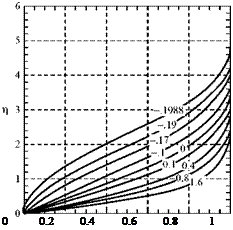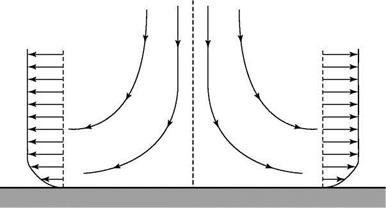Viscous Flow on Wedges
The pressure gradients that allow the Falkner-Skan equation to be an ordinary differential equation, given by:
1 1
Ux= cxm or p! = Pq – —p U2 = Po~2 p(cxm )2 (8.92)
 |
 |
correspond to the potential flow over wedges, as shown in Fig. 8.22.
u/U1 v/U i(Rex)1/2
Figure 8.21. Solution of the Falkner-Skan equation for various values of the pressure-gradient parameter, p.
|
в |
ЖР) |
B(P) |
f "(P,0) |
П8(в) |
|
-0.1988383 |
3.497798 |
0.868110 |
0.000000 |
5.0 |
|
-0.198800 |
2.332770 |
0.585389 |
0.005260 |
5.0 |
|
-0.190000 |
2.006747 |
0.576523 |
0.085702 |
4.7 |
|
-0.170000 |
1.778859 |
0.559664 |
0.162116 |
4.4 |
|
-0.140000 |
1.595897 |
0.538560 |
0.239737 |
4.2 |
|
-0.100000 |
1.442694 |
0.515044 |
0.319270 |
4.0 |
|
-0.050000 |
1.312361 |
0.490464 |
0.400323 |
3.9 |
|
0.000000 |
1.216779 |
0.469600 |
0.469600 |
3.7 |
|
0.100000 |
1.080320 |
0.435458 |
0.587035 |
3.5 |
|
0.200000 |
0.984159 |
0.408231 |
0.686708 |
3.4 |
|
0.300000 |
0.910995 |
0.385737 |
0.774755 |
3.2 |
|
0.400000 |
0.852636 |
0.366693 |
0.854422 |
3.1 |
|
0.500000 |
0.804550 |
0.350272 |
0.927681 |
3.0 |
|
0.600000 |
0.763974 |
0.335910 |
0.995837 |
2.9 |
|
0.800000 |
0.698683 |
0.311849 |
1.120269 |
2.8 |
|
1.000000 |
0.647904 |
0.292346 |
1.232589 |
2.6 |
|
1.200000 |
0.606902 |
0.276114 |
1.335723 |
2.5 |
|
1.400000 |
0.572872 |
0.262324 |
1.431587 |
2.4 |
|
1.600000 |
0.572872 |
0.262324 |
1.431587 |
2.3 |
|
Table 8.2. Properties of the numerical solutions for the Falkner-Skan equation |
|
S(*) = hg (P), |
|
, S * (x) = A(P) |
There are several interesting special cases for various choices of the в value. For example, if m = 0 and в = 0, the Falkner-Skan equation collapses to the Blasius flat-plate equation. The factors of 2 that appear to be different between the two equations result from definitions of some of the parameters but do not change the outcome of the calculation.
A useful special case is produced when m = 1 and в = 1. This yields the flow near a stagnation point, as illustrated in Fig. 8.23.

![]() Figure 8.22. Wedge flow for the Falkner – Skan equation.
Figure 8.22. Wedge flow for the Falkner – Skan equation.
|
Figure 8.23. Flow near a stagnation point using the Falkner-Skan solution. |
The external flow is expressed as:
U1 = u1x,
where for the case of the stagnation-point flow over a circular cylinder of radius R, the constant, Ui, is defined by:
9 U – щ = 2 -.
1 R
This is an important result because it can be helpful in starting numerical solutions in certain CFD applications, because the boundary-layer equations lose their validity near the stagnation point.














